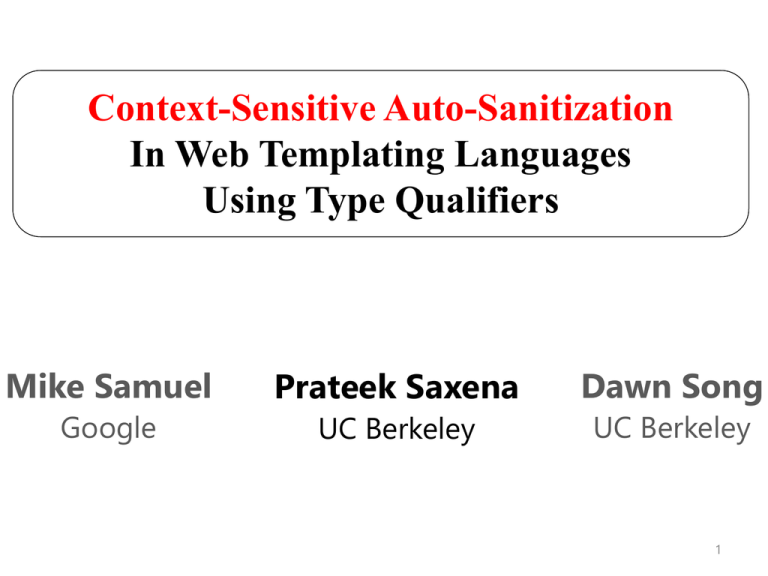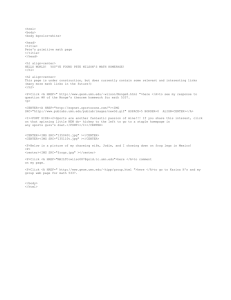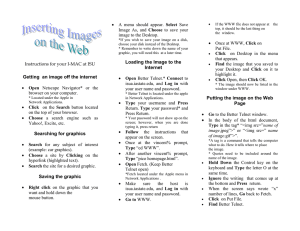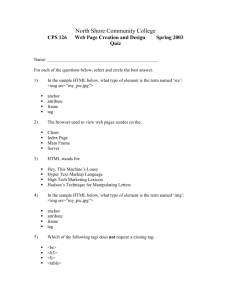Context-Sensitive Auto-Sanitization In Web Templating Languages Using Type Qualifiers Prateek Saxena
advertisement

Context-Sensitive Auto-Sanitization
In Web Templating Languages
Using Type Qualifiers
Mike Samuel
Prateek Saxena
Dawn Song
Google
UC Berkeley
UC Berkeley
1
Script Injection Vulnerabilities
• OWASP Top Ten Vulnerabilities
– 2nd in 2010 & 2011
• Today Affects
– Major Web Services
– Client-side Libraries
– Browser Extensions
– Devices & Smartphones
2
Predominant Defense Practice
String Div.Render ()
{
print(“<div>”);
print(userimg);
print(Sanitize(userimg));
print(“</div>”);
}
• Why Does it Fail?
Sanitizer
Library
– Developers forget to Sanitize
[Pixy’06, PhpTaint’06,Cqual’04, Merlin’09,Securifly’05, PhpAspis’11]
– Pick the wrong sanitizer [CCS’11]
3
Vision
Developer
Code
Application
Code
• Eliminate Scripting Attacks
– Make Applications Secure by Construction
4
Contributions
• A New "Push-Button" Defense Primitive
– "Security By Construction" Approach
• Context-Sensitive Auto-Sanitization (CSAS)
– New Challenge: Which Sanitizers To Place Where?
– Targets Existing Web Templating Frameworks
• It is Practical
Fast
Auditable
Compatible
Secure
• Deployed Commercially
– Google Closure Templates powers Google+
5
Web Templating Frameworks
Application
Template
template imgRender($imgLink, $name)
{
print (“<img src=\“”);
print ($imglink);
print “\”/>” . $name. “<br>”; return;
}
Template Code
Explicitly Separates Untrusted Inputs
calls
TemplateTemplating
Language does not have complex constructs
Framework
Compiler
Java
JS
Target Language Code
<script>
var o = new soy.StringBuilder();
imgRender({O: o,
imglink: $_GET(‘extlink’),
name: [$_GET(‘name’)] }));
document.write(o);
</script>
Application Code
6
Talk Outline
•
•
•
•
•
System Architecture & Features
Challenges
The CSAS Engine Design
Implementation
Evaluation & Deployment
7
System Architecture
Application
calls
Instrumented
Auto-Sanitization
Template
Compiler
CSAS
Java
JS
Sanitizer
Library
JS
Static Error
8
Auditability & Compatibility
• Easily Auditable
• Compatibility
Compiler
– No Developer Involvement
– Minimize Static Errors
• Security
• Performance
Java
CSAS
JS
Sanitizer
Library
JS
Instrumented AutoSanitization
Static Error
9
Security & Correctness (I)
• Property CSAN: Context-Sensitive Sanitization
template ImgRender($imgLink, $name)
{……………}
Attacks Vary By Contexts!
URLSanitizer
<img src="
HTML
Tag
Context
$name
URI START
Context
/img?f=
URI PATH
Context
$imgLink
URI QUERY
Parameter
Context
HtmlSanitizer
"/>
$name
<br>
HTML
Tag
Context
10
Security & Correctness (II)
• Property NOS: No Over Sanitization
<img src=" /
$name
/img?f=
$imgLink
"/>
$name
<br>
Sanitize Only Untrusted Data
Not Constant Strings
11
Security Assumptions
• Canonical HTML Parser
– Flexible to recognize browser differences [GWT, CTemplates]
• Correct Sanitizers
– Extensive Community Effort [OWASP, HtmlPurify, GWT, Django]
– Research on Secure Sanitization Primitives [Bek’11,
Hampi’09,Min’06]
– Already Used in Many Frameworks
Challenges
•
•
•
•
Easily Auditable
Compatibility
Security
Performance
Security
Performance
Compatibility
13
Approach #1:
Context-Insensitive Sanitization
template ImgRender($imgLink, $name)
{
javascript: bad();
print (“<img src=‘”);
src=”);
x := HtmlEncode($imgLink);
$imgLink;
print ($x);
print “’/>”
“/>” ..$name
HtmlEncode($name
. “<br>”; return;
). “<br>”; return;
}
False Sense of Security!Security
Performance
Compatibility
14
Approach #2:
Context-Sensitive Runtime Parsing (CSRP)
Security
template ImgRender($imgLink, $name)
{……………}
Performance
URLSanitizer
<img src="
$name
URI START
Context
Compatibility
URLParamSanitizer
/img?f=
$imgLink
URI Param
Context
15
Rich Language Features
template ImgRender($imgLink, $name)
{
print (“<img src='”);
x :=
“/” . $name. “/img?f=”. $imgLink;
print ($x);
print “'/>” . $name. “<br>”; return;
}
<img src=' /
$name
/img?f=
$imgLink
'/>
$name
<br>
16
Rich Language Features:
Control Flow
template ImgRender($imgLink, $name)
{
print (“<img src='”);
if ($name != “”) then
x := “/” . $name. “/img?f=”. $imgLink;
else x:= $imgLink;
fi
print ($x);
Ambiguous:
printUsage
“'/>” Contexts
. $name. “Statically
<br>”; return;
}
Sanitization Requirements vary by path!
<img src=' /
$name
/img?f=
$imgLink
'/>
$name
<br>
17
Our Approach
• CSAS Engine
– Context Type Qualifiers
Untyped
Template
Type Inference
Compiled
Code
Well-Typed
IR
Compilation
18
Context Type Qualifiers
• Context Type Qualifier:
– "Which contexts is a string safe to be rendered in"
TERMS
<img src='
TYPES
𝐻𝑇𝑀𝐿_𝑆𝑇𝐴𝑅𝑇
𝑈𝑅𝐼_𝑆𝑇𝐴𝑅𝑇
$imgLink
Type Inference: Where To Place Sanitizers?
x:=“<img src='” . $imgLink;
y:= UrlAttribSsanitize($imgLink)
𝑈𝑅𝐼_𝑆𝑇𝐴𝑅𝑇
𝑈𝑅𝐼
x:=“<img src='” . y;
𝐻𝑇𝑀𝐿_𝑆𝑇𝐴𝑅𝑇
𝑈𝑅𝐼
19
Implementation & Evaluation
• Google Closure Templates
– Powers several Google products
– 3045 LOC Java
• Evaluation Benchmarks:
– 1035 templates from production Google code
– Rich Features
• 2997 calls
• 1224 print/sink statements using 600 untrusted input
variables
21
Evaluation: Compatibility
• All 1035 templates auto-sanitized!
– No Developer Involvement
– No Static Errors
• Compared to original sanitization
– 21 cases differ out of 1224
– CSAS engine inferred a more accurate sanitizer
22
Evaluation: Security
Context-Insensitive Approach Fails on 28% prints
1
3
7
10
15
27
33
39
filternormalizeURI
filterHtmlIdent
escapeHtmlAttributeNospace
escapeHtmlRcdata
escapeUri
escapeJsString
filterCSSValue
escapeJsValue
filterNormalizeURI, escapeHtml
escapeHtmlAttribute
escapeHtml
0
UNSAFE
231
100
200
300
380
400
602
500
600
700
23
Evaluation: Performance Overhead
• Benchmarks
– Templates Only, No Other Application Logic
• Base: No Sanitization
Order Of Magnitude Faster
Than
CI
CSRP CSRP
CSAS
Chrome 9
3.0%
78.8%
FF 3.6
9.6%
JavaScript
Practical Performance:
Upto425%
9.6%
Safari 5
Java
Java
3.0%
9.6%
2.5%
189%
3.1%
CI
CSRP
CSAS
0%
72%
0%
24
Conclusion
• CSAS: A New "Push-Button" Defense Primitive
– Fast, Secure, Compatible and Auditable
– Increasing Commercially Adoption
6000
5000
4000
3000
2000
1000
0
July
Today
• Other Frameworks
25
Thanks
Questions?
http://code.google.com/closure/templates/docs/security.html
26




